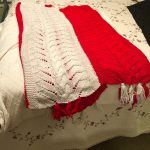
Growing up, the most tangible part of my mom’s family was a collection of crochet blankets acquired from funerals and my mom’s childhood home. My grandmother Joan Frances died before I was born, and my great grandmother Frances Jane lived in Pennsylvania in a nursing home before she died in 2008, so the blankets were how I connected with the two women who were my namesakes. My mom kept the blankets in her closet, some wrapped carefully in plastic comforter bags. In the winter they would come down from their perch and be distributed throughout the house.
My mom’s favorite has always been a mint green blanket with rainbow granny squares throughout that her aunt made. It’s still soft and the yarn is still smooth, and it’s so big it can cover an entire queen-sized bed. From a young age, my favorite has always been a candy cane striped blanket. It’s a little rough around the edges and the yarn is pilled with use and age. When I was a child, I’d carry it around the house like a cape. I always hated putting it away when extra blankets weren’t necessary, and some springs I would even convince my mom to let me keep it out. I loved it especially because my great grandmother made that blanket. Even though I didn’t bring it to university with me, we still have it, and right now it’s probably safely in my mom’s closet. My grandmother, Joan Frances, was born in 1931. Her mother, Frances Jane, was a talented crocheter for most of her life. In the 1930s, when resources were scarce and money was tight, it’s likely that my great grandmother crocheted many things for my grandmother throughout her childhood. My favorite blanket might not be from the 1930s, but my great grandmother’s crocheted creations were definitely draped over bed and decorating couches during the Great Depression.
Although all of my crochet keepsakes from my grandmother and great grandmother are blankets, crochet trends during the Depression included many other things. In the 1930s, popular things to crochet included clothing pieces and home decor. According to “Vintage Crochet History: Crochet in the 1930s,” popular items included edgings on blankets and other fabric items and doilies. Children’s clothing was also a popular project. Women even crocheted their own lingerie! My great grandmother probably crocheted clothes for my grandmother and her brother in the 1930s. For herself and as gifts for other women, she probably crocheted accessories, because matching accessory sets like hats and purses were popular patterns in the 1930s. In the latter part of the decade, specifically 1939, religious patterns became all the rage. My grandmother would have received her first communion in either 1939 or 1940, at the age of 8, and these patterns would likely have been used in some decorative capacity for that event. Crochet was such a popular craft during the Depression that there was even a novel written about it in 1930 called “The Crochet Woman” by Ruth Manning Sanders, which is about a queen who uses crochet to cast evil enchantments (Kathryn NN).
Mercerized cotton yarn was popular in the 1930s, especially when making lace crochet goods like doilies or lace appliques and when edging blankets. Mercerized yarn has been treated with sodium hydroxide to better retain dye colors. This process also helps yarn keep its strength under pressure and during the day to day wear and tear a crochet good undergoes (Jackofsky). In keeping with the thrifty nature of the Great Depression, crocheting with recycled materials also became popular. There were entire pattern books about crocheting using recycled plastic material, like cellophane or plastic bags. Crocheting rag rugs was also a popular craft and pastime because it used and reused materials the average person would already have. Scraps of old clothing, towels, sheets, old rugs, or even sack cloth could be repurposed into a comfortable, warm rug to lay over the floor in the winters (Kathryn NN).
Lace crochet, a specific type of crocheting that is small, intricate, and delicate, was extremely popular in the 1930s. The end of the decade saw the introduction and increase in popularity of textured stitches, like the bobble stitch. The bobble stitch is still used today, especially when crafting beanies and things for children. Most people learned to crochet using books or manuals that taught stitches and included simple patterns. A lot of pattern books in the 1930s included instructions for both knitting and crocheting projects, which suggests that most crafty women knew how to do both (Kathryn NN).
Crochet in the 1930s was a frugal way for women to reuse and recycle. It provided comfort for their families as well as necessities like clothing and winter gear. My great grandmother created beautiful projects throughout her life, projects I am lucky enough to be able to touch and feel. I was inspired to learn to crochet because of these blankets, and I still know how and use my knowledge to create comforting gifts like my great grandmother and grandmother did. Crochet is my connection to my family, and I am grateful for it.
Works Cited
Jackofsky, Erica. “What Is Mercerized Cotton Yarn?” Lion Brand Notebook, 31 Mar. 2017, www.lionbrand.com/blog/mercerized-cotton-yarn/.
NN, Kathryn. “Vintage Crochet History: Crochet in the 1930s.” Crochet Concupiscence , 20
Mar. 2015. www.crochetconcupiscence.com/2015/03/vintage-crochet-history-crochet-in-the-1930s/.